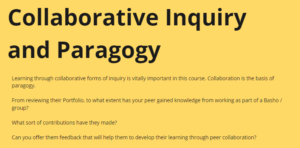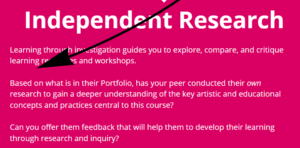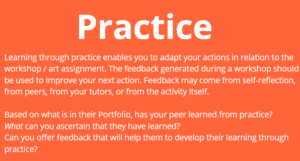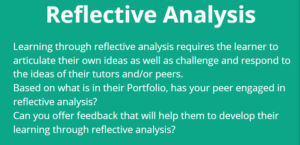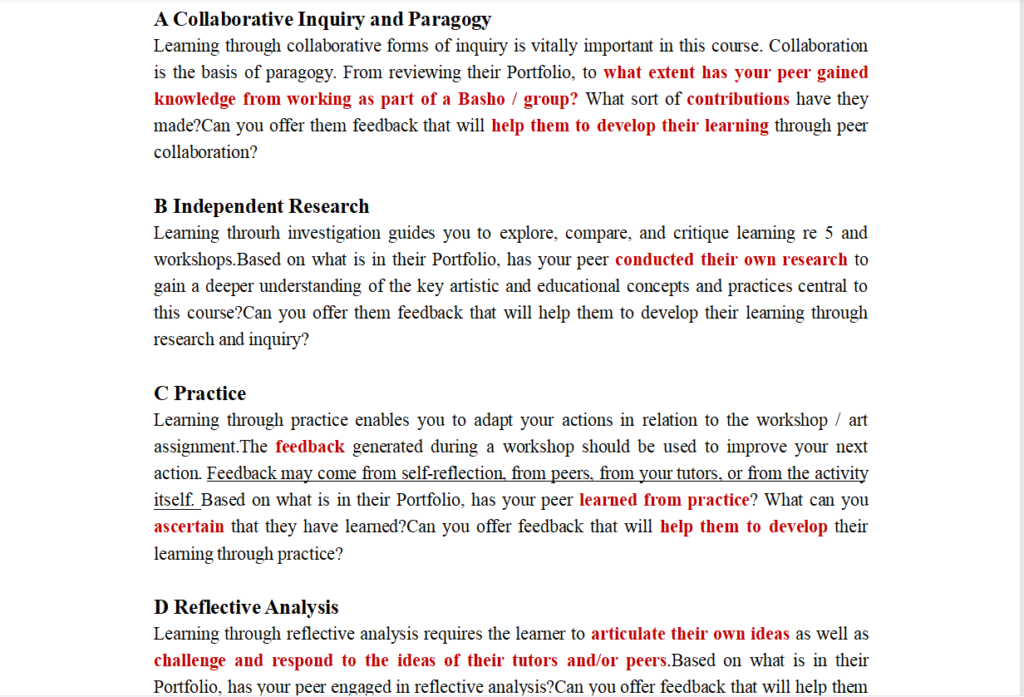Miro
In the beginning, I thought it was not a difficult task so I only planned two hours for myself. Little did I know that I would spend the whole afternoon understanding what Peer Review was and giving responses to my Peer in four aspects. Although I missed the Halloween party at school as a result and only ate a couple of chocolates from my neighbour at home alone, I felt that I had learnt a lot and it helped me to gain a deeper understanding of the meaning of Peeragogy.
I found keywords from the four perspectives and carefully searched Rui Shu’s portfolio for the corresponding points. If I didn’t find them, I dropped him a sticky note on miro to remind him of them. Reading from front to back, I saw a huge improvement in Rui Shu’s ability to learn and think logically, which was very exciting for me, both for seeing the growth of the peers we were studying with and for proving that the benefits of the course for us were visible. It also helped me to realize the significance of Peer review and fall in love with Peeragogy even further!
Week 1 | Art Assignment Create your Basho’s Covenant
A Collaborative Inquiry and Paragogy
Rui Shu has done very well in this part. He regarded him and his team Blue basho as an intimate group and shared the process and results of their cooperation in establishing Covenant. It can be seen that he has made many contributions and expressed many profound opinions in the group cooperation.
B Independent Research
He has a deep understanding of this practice, quoted’ Nishida philosophy’, “logic of place” and other theories, and personally analyzed and explained them. He has made his own independent research and analysis on the form of curriculum design and teaching mode, fully absorbed the contents of this course, and put forward his own ideas for creative improvement of education.
C Practice
His in-depth understanding of this practice helped him to complete this practice excellently. He first reflected on the principle of practice, and with the support of the theory, he became more proficient in practice. Later, he further developed his ideas in peer cooperation and perfected Covenant under the guidance of his teacher. I can be sure that he understands and adapts to this learning mode.
Can you show me your own Covenant Miro board?
D Reflective Analysis
He made a profound reflective analysis of this practice, including his understanding of concepts and his own experience of practice. At the same time, I put forward my thoughts and expectations for future study. His attitude of study and reflection is very serious, which is worth learning by all of us.
Week 2 | Swarm ReadingPeeragogy 3.0 in your Basho
A Collaborative Inquiry and Paragogy
In the second week, Shu Rui introduced the difficulties encountered in the first group reading and sharing with his blue basho. After sharing, he became confused about the context and could not understand each other’s contents. However, they did not rush by, but were determined to analyze the existing problems in cooperation and how to improve them. Although this sharing is challenging for them, I am sure that they have learned a lot from each other that they never had before. Shu Rui also put forward improvement measures for future problems in this cooperation. Although the results were not perfect, they had a rich harvest.
B Independent Research
In the face of difficulties encountered in the sharing process, Shu Rui chose to search the literature about group work to help him understand and solve problems. He analyzed the factors of successful team cooperation through Gander’s theory, which helped him to form and develop his own research on peer studies. For the construction of his theoretical model, it also has a guiding role for their future cooperation practice.
C Practice
In the process of group reading, he learned useful knowledge from the chapters he read and listened to his peers’ opinions. He put forward suggestions for improving the cooperation mode between himself and the group and also learned how to coordinate and divide labour from the activity mode of group reading itself. He gained a lot of useful information in this practice.
When the shared content is difficult to understand, would it be possible for you to try to ask two team members who are related to the reading section to analyze any new content updates? And so on? Will it be better than everyone’s rereading?
Would it be possible for you to listen to all the people’s sharing, and then take turns to guess and point out the unreasonable explanations of some team members?
If you can’t understand the logic and meaning after sharing, could you share the difficulties with red basho? Would it be possible for team members who read the same chapter at the same time to exchange information?
D Reflective Analysis
When group reading encountered difficulties, Shu Rui made many serious and detailed reflective analyses, and I was very impressed with his feedback and suggestions on this activity. When faced with difficulties in group sharing, he first chose to lead the group in a retrospective reading, calmly dealt with the problem, offered constructive comments during the discussion, and then reviewed the literature for review and conclusion afterwards. From a bystander’s perspective, he presented the crux of the problem and a vision for future collaboration. I think he wrote this part very well, and this analytical thinking is worth learning.
Week 3 | In the Open
A Collaborative Inquiry and Paragogy
In the third week of OER learning, Shu Rui outlined the importance of OER for Peeragogy and engaged in OER-related discussions and practice with his peers. He describes this part relatively little, however.
Will the learning style in OER be beneficial to Peeragogy? How can OER help Peeragogy?
B Independent Research
To what extent can OER help you build your own research?
C Practice
How likely do you think you can use OER open resources? How will you use it in practice?
D Reflective Analysis
He put forward the reflective analysis of OERwere believed to provide economies of scale through 4R theory, and considered the significance of oer to Open practices.
Week 4 | Unlearn Crosstalk
A Collaborative Inquiry and Paragogy
He and his blue basho completed the unlearn learning task. During the cooperation, he and blue basho came into contact with the “mod” course materials, cooperated in adapting and remixing art courses, and understood the significance of this learning method.
B Independent Research
He summarized and formed his own research in unlearn study. He described the traditional teaching model as a linear structure, while describing the new unlearn and undo as a new spiral art learning model. The formation of this framework and model is helpful for his future artistic creation.
C Practice
In this practice, he learned new ideas from his peers, and gained new concepts and understandings from the model explained by the professor, thus forming his own theoretical model.
D Reflective Analysis
He reflects on the professor’s model and believes that it makes sense. Rui Shu constantly reviews past course content and relates it to the current course as he learns, and finally comes up with his own new idea, forming a closed-loop learning model, learning and experiencing as he reviews and creates.
Week 5 | Educational Turn Redux
A Collaborative Inquiry and Paragogy
He engaged in a structured discussion of three issues in the group collaboration, considering global examples of the educational turn, catalysts for encouraging the turn and the link between educational aesthetics and realistic politics. Blue basho’s collaborators were more positive and effective in their discussions, and had a clear logic and structure for their perceptions of the issues in the collaborative process. Rui Shu contributed many of his own ideas and examples of the educational turn and gained a deeper understanding of it.
B Independent Research
In the second question, Rui Shu presented his views from the examples cited and developed his own research ideas from the theories and phenomena. He selected quotations that fit the topic and developed a viewpoint of academic significance.
C Practice
In the first question, he selected some artists’ institutions and art schools as examples to prove his views. It can be seen from this practice that he has a clear understanding and cognition of the educational turn. And the selected examples are more professional and specific than before.
D Reflective Analysis
As for the third question, in the process of demonstrating educational aesthetics, he formed his own relatively complete and comprehensive judgment and analysis of the problem. By defining, making analogy and comparison, giving examples, and summarizing the discussion process, it is in line with the process steps summarized by keyword that the professor asked us to practice before. His reflective analysis is constantly improving.
